LEARN THE 4 C’S IN 4 MINUTES
DIAMOND CUT, COLOR, CLARITY, AND CARAT WEIGHT SIMPLIFIED
This post contains affiliate links. If you use these links to buy something I may earn a commission. Thanks! As an Amazon Associate I also earn from qualifying purchases.
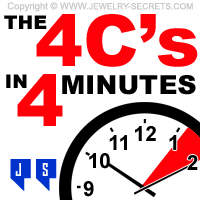
Time is valuable.
So is learning.
This is why I put together…
The 4 C’s in 4 Minutes.
Talk about fast learning. This post is easy to read, easy to scan, full of great looking pictures and information. Plenty enough to teach you the basics of diamonds, grading and the 4C’s.
With no further delay, I present…
The 4C’s (quickly)
When jewelers refer to the 4C’s of diamonds, they are referring to 4 main characteristics that help identify, classify and price diamonds.
The 4C’s are:
Cut, Color, Clarity & Carat Weight
Let’s take a closer look at them…
Diamond Cut
The cut of a diamond is not necessarily the shape of the diamond. Shapes are like: round, square, oval, heart… like the picture below…

Cut is more than that. Cut is actually the cutting style. Cut stands for the proportions, the finish, the symmetry and the angle of the facets.
Cut plays a huge role in the beauty of a diamond. If the diamond is cut well, the stone will look bigger, brighter and have more flashes of white light (brilliance) and colored light (fire) in the stone.
The most popular diamond cut is the round brilliant cut…
Brilliant Cut
Hands down, the round brilliant cut rules the market. But then again, it is the most brilliant diamond of any cut there is (because it’s totally symmetrical).
The brilliant cut has 58 facets; 33 on the top (called the crown), and 25 on the bottom (the base, point, or pavilion).
Take a look at them…
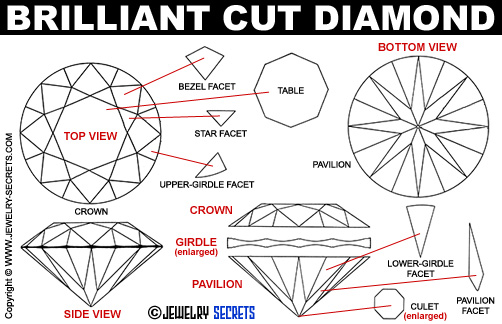
Some brilliant cut diamonds are cut very thin and shallow. Those cuts are called spread stones (or fish-eyes). They look huge, but often lose light, life and can actually chip or break easier.
Other stones could be cut too deep and will look dull, dark and lifeless (called nail heads).
Take a look at how light interacts with a shallow stone, ideal cut stone, and a deep cut…
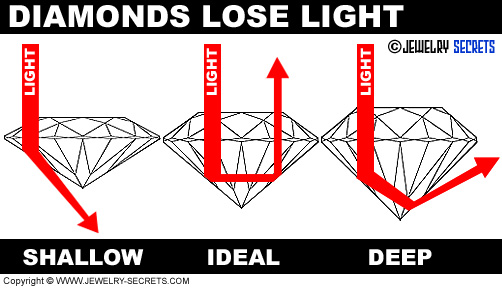
If the stone is too deep or too shallow, you lose light.
Ideal Cut
The best cut you can get, is a cut that’s ideal proportions.
Ideal cuts are where the diamond is cut within an ideal range (percentage guideline) and it allows the stone to maximize light, brilliance and fire (more sparkles, which is called scintillation).
Now, we could get really technical and detailed and talk about the two main percentages, which are the table percent (percents are based upon the size of the table in comparison to the size of the girdle – the widest part of the diamond), and the depth percent (the entire depth of the stone, a combination of the crown, girdle and pavilion). We could learn that the ideal percentage range for the table should be between 53% – 57%, and the ideal percentage for the depth should be between 57.5% – 63%…
As in the diagram below…
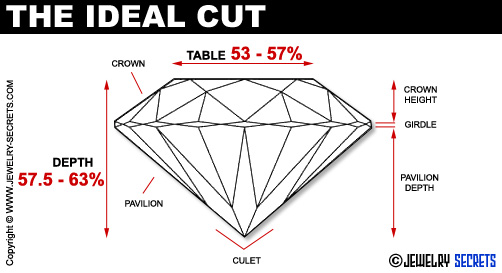
But that’s too much to learn.
GIA actually made cut simpler to understand.
They came out with cut grades that rate the way a diamond is cut into 5 grades: Excellent, Very Good, Good, Fair, and Poor.
These cut grades are listed on a diamond report (certificate), and the ones to strive for are: Excellent, or Very Good in the least.
Those will make your diamond pop and sparkle.
Which brings me to a very important note:
Don’t buy a diamond, especially loose, if it’s not certified. I recommend GIA (the Gemological Institute of America). GIA wrote the 4C’s. They devised the charts that everyone across America uses to grade their diamonds with. There’s nobody better to grade your diamond than the people who wrote the book.
Moving onto color…
Diamond Color
Color is broken down into 5 main color categories (and as you can see, there is no A, B or C).

Colorless
Colorless (the best color range to buy) is D, E, and F color.
Near Colorless
Near Colorless (the most popular colors on the market – because of availability and price) is G, H, I and J.
Faint Yellow
Faint Yellow are diamonds with the colors of K, L and M (I don’t recommend them).
Very Light Yellow
Very Light Yellow is not so very light… It actually starts to look really yellow. They are the colors of N – R.
Light Yellow
Light Yellow looks very yellow. You can’t mistake them. They are the color ranges between S – Z.
Fancy Colors
Fancy Colors are any color of diamond below the Z grade (Z+). Fancy colors have a strong vivid color and can get very expensive. Colors like: brown diamonds, pink diamonds, blue diamonds (the hope diamond) and canary yellow diamonds.
As you can see from the categories, most diamonds have a slight yellow hue to them. In fact, the only color range that has no color whatsoever is the top of the line, D, E and F colors.
No Color
D, E and F is the best you can get. There’s nothing better or whiter on the market.
Personally, I love colorless diamonds (like these diamonds here). They look so bright and white. Stunning. I highly recommend them.
If you put a colorless diamond up against a diamond with a yellow hue, you’ll surely see the difference. It’s like night and day.
Most Popular Color
The most popular diamond colors are the near colorless ranges: G, H, I and J.
To most people, these diamonds will still look white. I do recommend sticking to the higher end (G or H). That way your diamond is considered fine white and will still look bright with no apparent color.
Moving onto clarity…
Diamond Clarity
Clarity basically means, the amount of flaws or imperfections a diamond has. The lesson to learn here is: The less flaws, the better.
Flaws are things like: clouds, lines, feathers, pin points, cracks, nicks, pits and the most popular inclusion; black carbon spots (looks like pepper). Flaws are like freckles and moles on people. Everything born in nature has some.
Carbon spots are the easiest inclusion to see in a diamond because they are dark spots that contrast with the stone. You can normally see carbon spots with the bare eye. They are most commonly found in I clarity stones. I advise you to stay away from them.
Clarity is broken down into 6 main categories:
6 main clarity grades:
Starting at the top of the clarity chart (the best), we have flawless. Then as the chart progresses down, you see the presence of more and more inclusions until you finally get down to I3 clarity (the worst), where you will see tons of flaws.
Take a look at the diamond clarity chart.
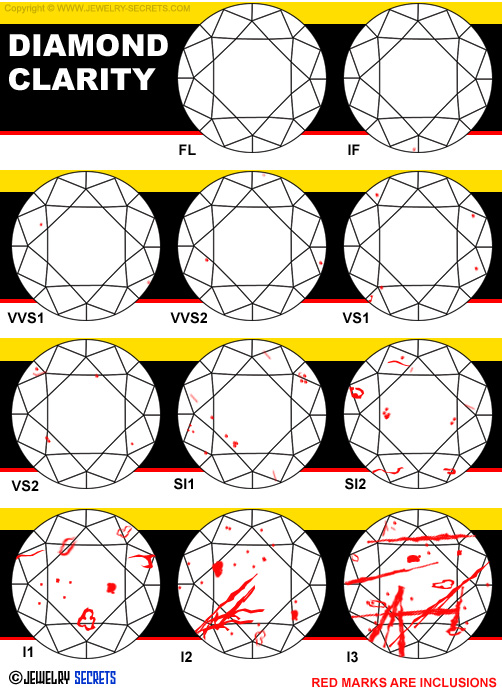
Let’s take a look at them…
Flawless
Flawless has no inclusions inside or outside of the diamond. There is nothing better than flawless. It’s as perfect as can be.
Flawless diamonds are almost impossible to find and they are very rare. Which also means, they will cost you a pretty penny.
Internally Flawless
Almost as perfect as flawless, but with a nick or natural (like a trigon) on the outside of the stone. The inside (internal) is flawless, the external has some sort of identifying characteristic to it. Internally Flawless stones are rare and very valuable.
VVS Clarity
VVS clarity is one step lower on the charts. VVS is broken down into 2 grades: VVS1 and VVS2. VVS means very, very, slightly included.
The inclusions in a VVS diamond are extremely small and extremely difficult to see under 10x magnification (even by an expert).
To most people, VVS will still look perfect.
VS Clarity
VS is next. VS means Very Slightly Included. It’s broken down into 2 grades: VS1 and VS2. VS1 being slightly better than VS2.
VS clarity is by far, my favorite clarity. VS looks spectacular (see VS diamonds here). The inclusions are hard to see under magnification. I love them and highly recommend them.
They really are beautiful diamonds with just a hint of flaws seen under a scope. Simply awesome!
Next we get into the popular portion of the clarity chart… The most popular clarity on the market (because of the looks and price). That clarity is SI…
SI Clarity
SI clarity (one step down from VS) means slightly included. It’s broken down into 2 grades: SI1 and SI2.
To the bare eye, SI clarity diamonds look clean (eye clean). You’ll see no inclusions or flaws with the eye (almost – some people have incredible eyesight and will still spot them). Normally you’ll need a microscope to see them.
Under magnification, inclusions in an SI stone will be easy to spot.
SI1 clarity is a great clarity to buy.
SI2 clarity is questionable. But that’s only for one particular reason: from a side view, SI2 clarity diamonds may have some eye-visible inclusions in them (like black carbon spots). You may be able to see these if you look for them. From a top down view, the diamond should face up fine… But from a side view = maybe not… Every diamond is different. You have to look at them to judge for yourself.
There is one more clarity in SI group that GIA does not recognize, and that clarity is called SI3.
SI3 Clarity
SI3 clarity is supposed to be another clarity added to the SI range (again, not recognized by GIA), that are really only glorified I1 clarity diamonds. That’s what GIA will grade them as if you send them the stone. That’s why I don’t recommend purchasing SI3 If you want an I clarity diamond, buy an I clarity diamond. If you want SI clarity diamond, buy SI1 or SI2.
I Clarity
I clarity is the last and lowest clarity range on the charts. I clarity means: imperfect or included.
I clarity is broken down into 3 grades: I1, I2 and I3 (I1 being the best of the bunch, I3 being the worst). I3 is right above industrial diamonds (which are highly included diamonds that are only used for drill bits, saws, or tools).
I clarity diamonds will have larger (and sometimes massive) inclusions in them. Inclusions and flaws that are easy to see with the eye (you won’t need a microscope or a 10x jeweler’s loupe to see them). You’ll be able to look down at the stone and see large cloudy areas, cracks, lines, or dark spots.
If you see flaws in your diamond, then it’s an I clarity stone.
I advise staying away from them. Unless you just don’t care about quality and only want to buy a large diamond at a discounted price.
Most people are much happier with SI clarity. And for those that want the best of the best… look at VS or VVS.
Certification
Above all else, make sure you buy a certified diamond (GIA). If the certificate has a diamond plot (which is a drawing or diagram of the inclusions in the stone), you will quickly be able to see what’s inside the diamond.
You can look at the plot and then look at the diamond under a microscope and compare the plot to the inclusions you see. It should make finding them and identifying your stone easier.
Take a look at a couple of sample diamond plots…
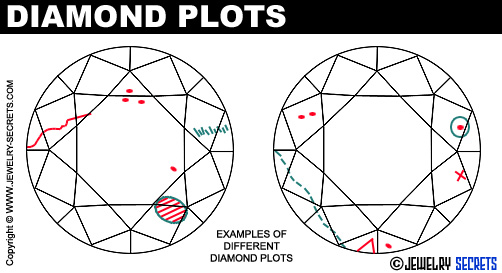
Looking at a diamond under magnification is the only way to buy them. You must take a closer inspection… You need to see what it is you’re buying.
Laser Inscriptions
Taking the diamond certificate one step further, I would also advise you buying a laser inscribed diamond.
That’s a diamond that has the diamond certificate report number laser etched (burned) right onto the side of the stone (on the girdle).
Laser inscriptions are proof positive that the diamond you’re looking at, matches the diamond listed on the report.
Laser inscriptions are the best way in the world to prevent diamond switching. You can microscope your diamond before and after you drop it off at the jewelry store for sizing or repairs. Look at your numbers. Match them to the certificate. Guarantee that you get your diamond back. It’s peace of mind and smart.
Lastly, let’s move onto carat weight…
Carat Weight
Think about carat weight like money (as most of us do).
A one dollar bill equals 100 pennies, right? Well, that’s just like a one carat diamond, which equals 100 points.
Likewise a half carat diamond (think 50 cents) is 50 points.
A quarter carat (like a real quarter) has 25 points.
See the similarities? Carat weights break down just like dollars and cents.
Take a closer look at the carat weight chart…

5/8 of a carat would be 58 points, which is in between a half carat (.50) and a 3/4 carat (.75). It really is that simple.
Think money, and you’ll understand weights just fine.
The average carat weight is just 38 points, the “dream” carat weight is 1.00 carat.
Buy the biggest you can afford without skimping on cut, color or clarity.
The bottom line:
So now you know the shortened version of the 4C’s. I have a longer version that goes into much more details here: The 4C’s. Whether or not you could read this post in 4 minutes is another thing… I just liked the title. It’s catchy. :)
There is so much more to learn about diamonds and grading. This whole site is filled with great articles about diamonds, quality, and buying guides. You can go so much deeper and learn more if you want. But for now, that’s the 4C’s of diamonds.
If you liked this post, please tweet about it, or share it on facebook.
And if you really want to learn more, check out my ultimate diamond guide.
And if you’re looking to buy a diamond, check out James Allen here.
Cheers! :)


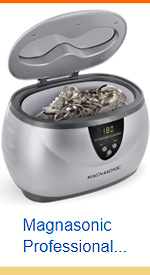

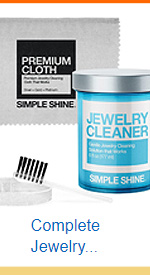
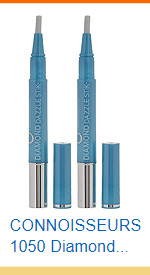
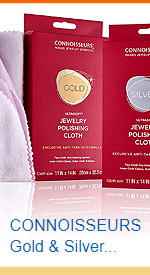
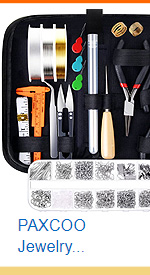
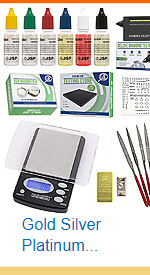
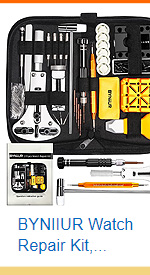
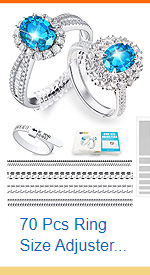
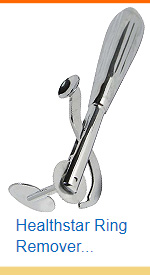
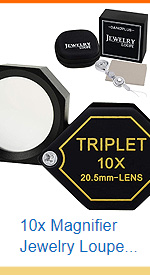
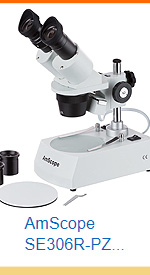




Leave a comment